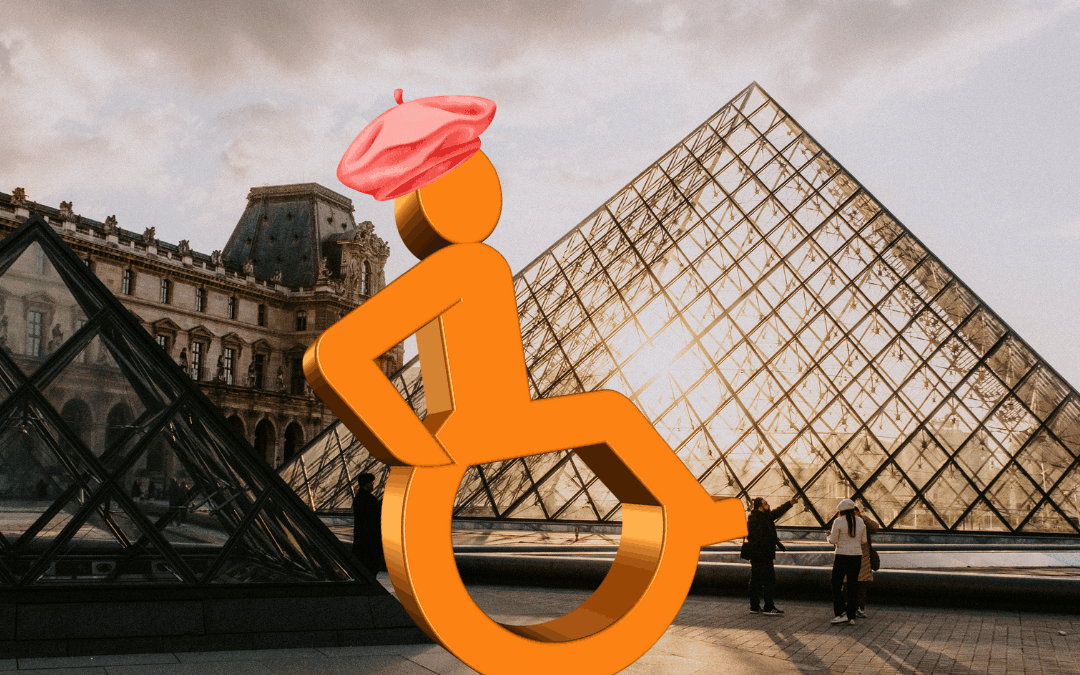Travelers with Handicaps in Paris: A Practical Guide
If you are a traveler with a handicap, with or without a wheelchair, Paris is not off limits! Many years ago, Paris wasn’t so easy to navigate in a wheelchair. But Paris has made tremendous strides in making their wonderful city accessible. In 2005, a law was passed requiring all museums and public spaces to be accessible to wheelchairs.
Read further to learn:
- the best and worst forms of transportation,
- the accessibility of your favorite destinations,
- hotel options,
- tips and much more.
Airport Transportation
The first transport you’ll need to deal with is at the airport. When you disembark, what next? Both major Paris airports, Charles de Gaulle and Orly, are equipped with facilities for handicap accessibility. At Charles de Gaulle, it is possible to gate-check your wheelchair, so you can use it up to the point of departure. Airport terminals have accessible restrooms. For more info on the airport layout and other helpful tips, check this link: www.aeroportsdeparis.fr.
There are a few ways to get to the city. The least expensive is to take the RER train. The RER is a set of several train lines that circulate in Paris but also go to the suburbs. There is an RER station at the CDG airport to take passengers into the city. You can make a reservation in advance for accessible RER travel into the city here: accesplus@transilien-sncf.fr. I do not recommend Roissybus, whether you have a handicap or not!
There are more convenient ways to go. Of course, a wheelchair accessible taxi comes to mind. Both taxi companies G7 and Taxi PMR have accessible vehicles. Taxis can take you right to your address, but are, of course, more expensive. Count on 50 euros and up. Lastly, there are private transfers, a private shuttle company that takes you directly to your hotel. Some companies (not vetted by the author) are Transfeero (starting price 40€), or Accessible Europe Holidays. There are many more of these available for the general public at about the same price points as taxis, some higher. Not all have wheelchair accessibility, so be sure to ask.
Best and Worst Forms of Public Transportation
Public transportation in Paris comprises the metro system, RER trains, buses, and trams. All forms except the metro are more or less adapted for handicapped travelers. Buses and trams are the best, and the RER is also fairly good. The metro system, which is the oldest and most extensive, is the worst for any kind of wheels, even suitcases and strollers. Only the line 14 (one of the newest) is adapted for wheelchairs. On this line you can (and should!) see Bercy Park and Bercy Village. (Also Bercy Stadium, if you have a concert or sporting event to see!)
Trams and buses: There are 9 tram lines. They circulate mostly around the perimeter of the city, which is only helpful in some cases. Platforms are level and trams are easy to access.
Buses go everywhere, and there are many more of them. They have wheelchair ramps in the middle doors. The disadvantage is the difficulty in deciphering the routes on the map. The bus stops themselves have easy-to-read postings of directions. Bus maps are available online, so you can download one and study it ahead. https://www.bonjour-ratp.fr/en/plans-bus/ Another advantage, people with wheelchairs travel free on buses and trams.
RER Trains: RER trains, particularly lines A and B, often have elevators and wider doorways (10 lines total; 5 main ones in the city) Small ramps to get on board are available, but must be requested in advance or on site from an employee. This isn’t always possible, but usually the gap is small enough to get over the threshold with no problem.
If you need assistance while traveling on public transport, intercoms are scattered throughout metro and RER stations. Personnel are on site daily to help if needed. Look for intercoms near ticket machines, elevators, platforms, and in some corridors.
Sites You Want to See…Can You Get There?
Here’s a non-comprehensive list of many popular Paris sites that are wheelchair accessible.
Louvre (18 elevators and 20 wheelchair lifts) ask for accessibility map; enter via the shopping center entrance on rue Rivoli and find the pyramid. A central courtyard under this pyramid has elevators. You can enter for free.
Eiffel Tower: elevator access by west and north pillars to the first and second floors. Inquire at ground level info desk.
Musee D’Orsay: This Impressionist and post-impressionist museum is accessible with ramps, elevators, and accessible restrooms. Wheelchairs are loaned to visitors who need them.
Musee de l’Orangerie: There is free entrance for people with disabilities and it’s wheelchair accessible, to enter and also from room to room.
 Notre Dame Cathedral: Visiting outside is not a problem. The area is level in front of the cathedral. The inside is open to visitors now, following a lengthy reconstruction. The lines are long, but there is a fast-track entrance ramp for wheelchairs.
Notre Dame Cathedral: Visiting outside is not a problem. The area is level in front of the cathedral. The inside is open to visitors now, following a lengthy reconstruction. The lines are long, but there is a fast-track entrance ramp for wheelchairs.
Arc de Triomphe: This is a “maybe”, though you can certainly see it from a distance. The tunnel under the roundabout is not accessible. The roof terrace is accessible, and there is an accessible restroom.
Sacre Coeur Basilica: You can take the funicular with a metro/bus ticket or have someone drive you to the church. There is an accessible entrance at the side of the basilica.

Gardens at the Chateau of Versailles
The Château of Versailles is accessible with elevators and accessible restrooms.
The Champs-Élysées is that famous avenue to stroll! The sidewalks are flat (not cobbled) and are very wide on both sides.
Tour Montparnasse: With 52 floors, you can bet they have a fast and efficient elevator!
Pompidou Modern Art Museum (with restaurant, panoramic view terrace, and library): step-free entrance & elevators are available.
The Rodin Museum has access ramps and accessible restrooms.
Luxembourg Garden (wheelchair ramp, accessible parking and toilets)
The Lido French cabaret is even accessible!
Some private tour companies have tours to some hard-to-navigate places (because of hills and cobblestone), like the Latin Quarter and Le Marais.
If there are places you want to visit but are unsure about, consult them in advance on their website if possible. When you arrive at the place you are visiting, ask at the welcome desk for accessibility maps.
Discounts
Trams and buses are free for people with wheelchairs. If you have a disability but don’t use a wheelchair, you can apply for a 50% reduction on public transportation. Learn more at www.ratp.fr.
Many museums and other sites have reduced or free admission for people with handicaps. (Louvre, Orangerie, Versailles, and more) If you don’t use a wheelchair and have a non-visible handicap, you’ll likely have to show proof to get the discount.
Hotels that are wheelchair accessible:
This link contains a list brought to you by the helpful website, Wheelchairtravel.org.
https://wheelchairtravel.org/paris-hotels/
General Tips
Book your stay in a central, flat neighborhood, such as Saint-Germain-des-Prés or Nation. The center of Paris (Chatelet area) is super-congested, so you might want to avoid that. Also, the Montmartre area is extremely hilly. You can certainly visit these places, but plan your hotel base in flatter areas.
Book your hotel in an area close to an RER station. The Nation and Opéra neighborhoods both have stations for the RER A, which can take you east to west across the city. Both have elevators.
Visit attractions within a small radius to minimize travel, allowing for frequent breaks. For section-by-section descriptions on everything to do in Paris (all 20 districts), see my book Magical Paris: Over 100 Things to Do Across Paris. The book enables you to see places close to one another, maximizing your time and travel.
Consider a specially adapted tour such as one of the companies listed below to maximize your visiting and minimizing discomfort and inconvenience. (not an affiliate, just a good idea!) If you’d like a private tour to a specific place, consider hiring an Uber for a couple of hours! Other companies are Kaptan and Le Cab.
Helpful Websites
From Paris Official transportation:
https://www.ratp.fr/en/accessibility/network-accessibility?ref=blog.wheeltheworld.com
from the Paris Tourist Office: https://parisjetaime.com/eng/practical-paris/visiting-paris-with-a-disability-i053
https://wheelchairtravel.org/paris/
https://www.parisinsidersguide.com/paris-in-a-wheelchair.html
https://blog.wheeltheworld.com/accessible-paris-attractions/
Bus Maps (free download) https://www.bonjour-ratp.fr/en/plans-bus/
https://www.sagetraveling.com/Paris-Wheelchair-Accessible-Travel-Tips
https://wonderswithinreach.com/2025/01/wheelchair-accessible-paris/
https://blog.wheeltheworld.com/accessible-paris-attractions/
Accessible Tour Companies
The Paris bus tour company, Tootbus, offers handicap accessible vehicles, with a wheelchair accessible entrance and seating. For more info consult this site: https://www.tootbus.com/en/paris/help/faq
Disabled Accessible Travel https://disabledaccessibletravel.com/accessible-destinations/france/accessible-paris/wheelchair-accessible-panoramic-driving-tour-of-paris-by-night/
Trapooz specializing in accessible travel https://www.tapooztravel.com/
Wheel the World https://wheeltheworld.com/
Sage Traveling https://www.sagetraveling.com/
Disabled Accessible Travel https://disabledaccessibletravel.com/accessible-destinations/france/accessible-paris/wheelchair-accessible-panoramic-driving-tour-of-paris-by-night/
(Note: These companies have not been vetted by the author.)
Paris is at your fingertips and ready for your wheels!
French for Travelers: It’s easier than you think! Learn MORE!





